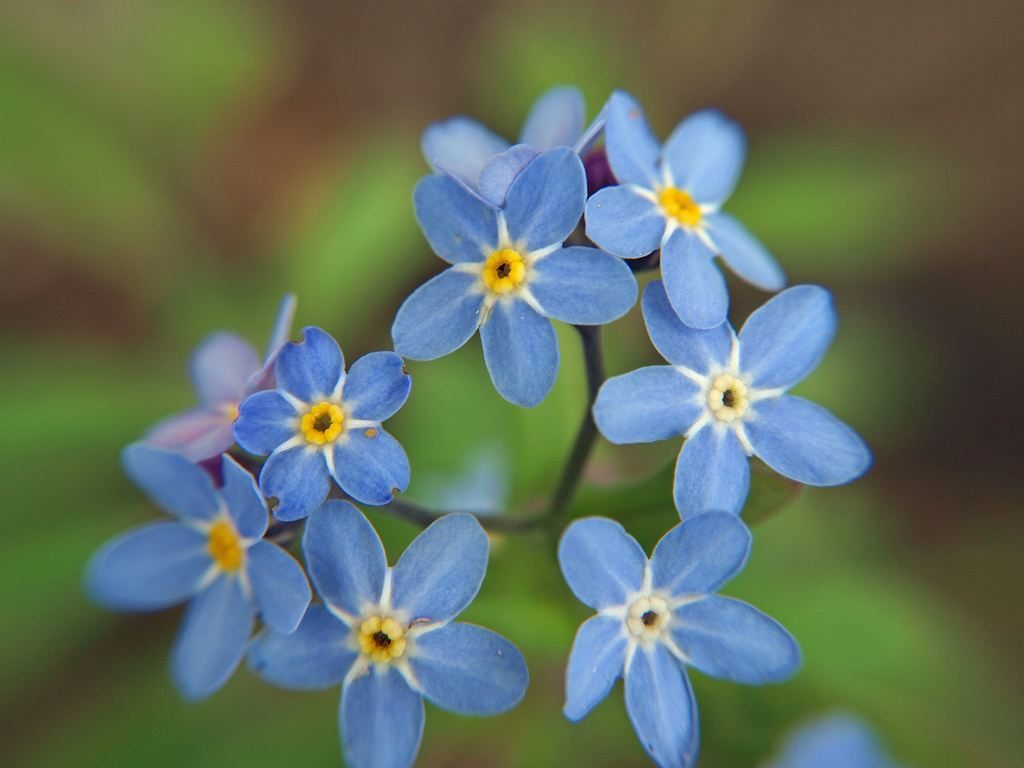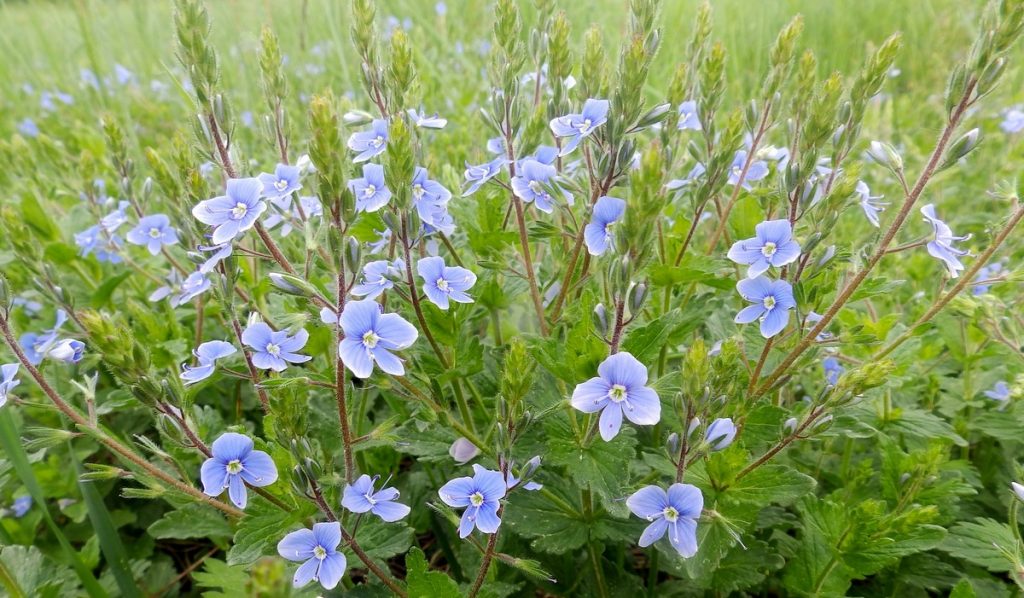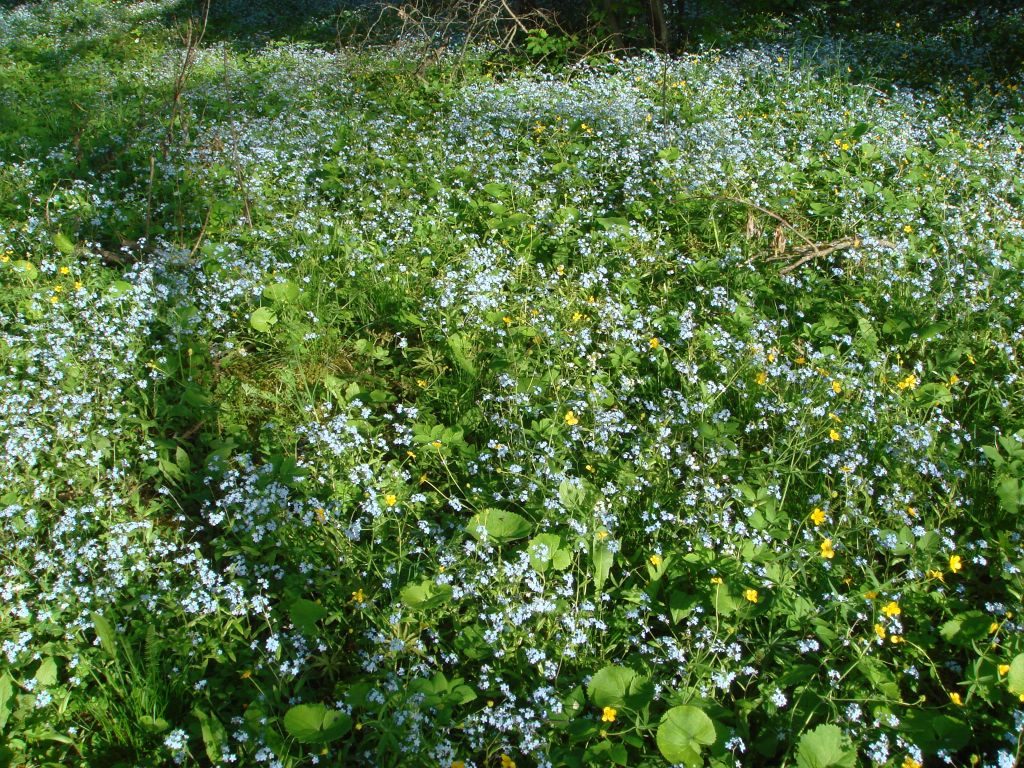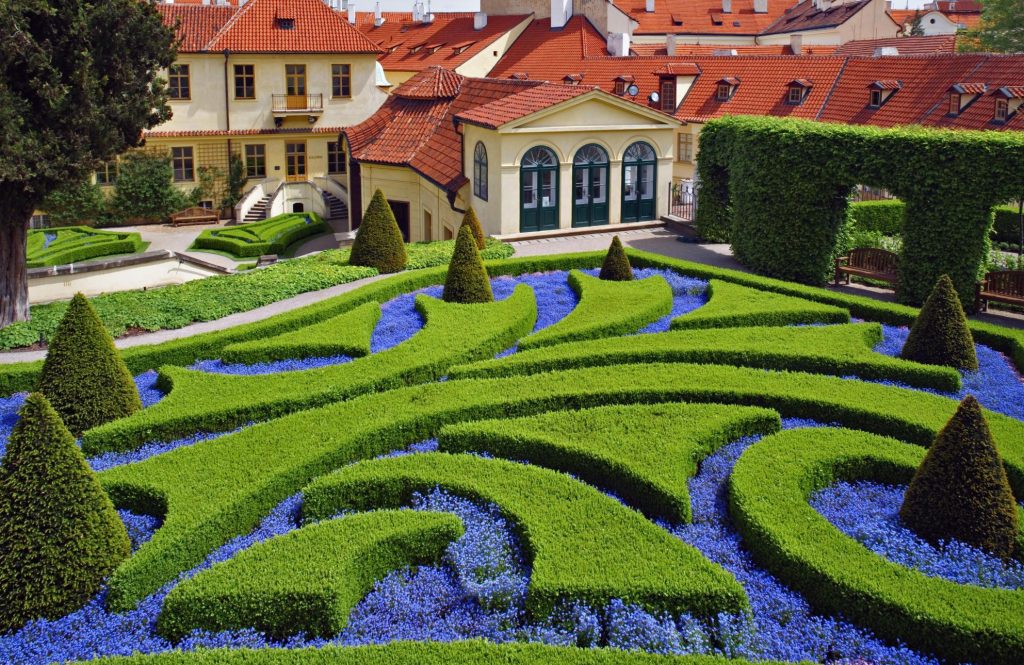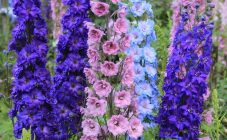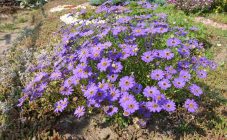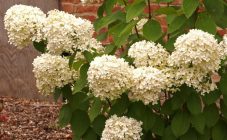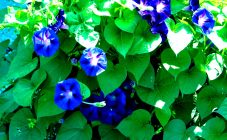Content:
Forget-me-nots most often you can find a variety with blue and pink flowering, it falls in the summer. Culture can be annual and perennial. How to plant and propagate it - further in the article.
Flower description
Forget-me-not is translated from Latin as "mouse's ear" and for good reason, since its young leaves are similar to the hearing organs of this animal. In fact, greens are very fluffy at the initial stage of growth.
What color are forest forget-me-nots? They can reach a height of 30 cm. The plant has a branched type of stems, and the flowers are collected in small inflorescences and have a pale blue tint. The foliage is alternate, sessile, lanceolate or linear-lanceolate. The plant needs high humidity and is resistant to shade, and therefore can adapt to absolutely any terrain, but planting under the scorching sun is undesirable.
The description of the forget-me-not flower says it has fruits. This coenobium, when ripe, breaks down into 4 nut-shaped and single-seeded cups. 1 g contains almost 2000 seeds with an ovoid shape and a shiny surface.
The Azov variety is considered fastidious, since the content in warmth and constant contact with sunlight is of great importance. The plant will actively develop in any soil. But he needs proper constant care to maintain an attractive appearance and delight the eye with a bright shade of flowers.
Forget-me-not Resteiner is a spectacular species that will cover the area with a dense blue carpet with a small amount of green leaves. The culture can be planted both independently and in combination with other flowers.
Types and varieties
There are about fifty species in the genus of forget-me-nots, which can be found on the territory:
- USA;
- South Africa;
- Australia;
- New Zealand.
In Russia, swamp forget-me-not and field forget-me-not are in demand. Plants of this family prefer high humidity and the presence of constant freshness in the soil, and according to other criteria, there are no special requirements for maintenance and care. There are also thermophilic species, which include the Alpine forget-me-not and meadow-forget-me-not, which prefer to grow under the sun. Domesticated species, created by crossing several varieties, have properties similar to those that grow outdoors in the wild.
Experienced gardeners are advised to take a closer look at forget-me-nots:
- rarely-flowered;
- alpine;
- swamp;
- forest.
In addition to the above varieties, several more are popular, which are also in demand, especially in landscape design. This is a forget-me-not:
- creeping;
- soddy;
- garden;
- small-flowered
- garden blue;
- oak;
- ordinary;
- Caucasian;
- pink.
Forget-me-not sod or marsh allows you to elegantly decorate the yard with bright blue flowers. In nature, these species spread along the banks of a river, stream or lake. The plant is resistant to moisture and shady areas, and therefore perfectly adapts to garden conditions.
The Alpine species got its name from the fact that it grows in the territory of the Alpine mountains. It belongs to perennial plants and has flowers of a dark blue hue.This crop requires a lot of sunlight, which must be considered when growing.
Features of planting and care
Fluffy forget-me-not is a flower that can fully meet the expectations of flower growers, as it will give positive emotions with its attractive appearance. But first you will have to try a lot to make it exactly like in the pictures on the Internet. Before planting seeds, for example, garden forget-me-nots, a suitable place is pre-selected: it is dug up, loosened, cleared of weeds.
For planting grown bushes, an area with leveled soil fertilized with humus and peat is also prepared. Top dressing is applied in small quantities, since an excess can affect the quality, especially of small-flowered forget-me-nots.
A hole is formed and drainage is required. A few pebbles are placed at the bottom of the hole or rubble is poured, after which they are sprinkled with sand. Forget-me-not is placed in the hole and carefully sprinkled with soil. After planting, abundant watering is required, and when the plant takes root, 2-3 times a week is enough.
If a florist plans to transplant a flower in the fall, you need to be in time until the first frosts come. The transplant can also be carried out when forget-me-nots are blooming. Everything should be done the same.
What does a properly cared sod forget-me-not look like? beautiful, with bright flowers, and most importantly, with a healthy look. In general, the plant needs regular watering, fertilization with various dressings, as well as vitamins and minerals, treatment from pests and to prevent diseases.
In order for the culture to grow well and delight with large flowers, some recommendations are required:
- Top dressing is applied in moderation, preferably before flowering, to give the plant strength and improve immunity.
- At the end of flowering and before the onset of frost in perennial varieties, it is required to cut off all the stems to the roots and cover with spruce branches.
- If the forget-me-not is annual, then at the end of summer it is dug up and removed from the garden, having previously collected the seeds from the tops.
- Forget-me-nots will bloom for a long time and beautifully if they are regularly watered, and you need to pour it under the foliage, and not on it.
- As soon as the first signs of a disease or pest appear, the culture is quarantined and treated with special solutions. All damaged leaves are removed.
Forget-me-not is an ordinary plant, not a medicinal one, so it is used only for the purpose of decorating the backyard area. How to propagate it correctly so that a chic bluish carpet covers the entire yard?
In many cases, planting in open ground occurs as an adult as a shrub, but reproduction is carried out by planting seeds or cuttings. Each gardener chooses the method that suits him the most in terms of technology and efficiency, but you need to take into account some nuances:
- After seed germination, it is worth pre-preparing the beds. This is done at the beginning of summer, provided that at night the air temperature reaches 15-18ᵒС. It is advisable to pick up the seedlings in separate trays before these, and only then transplant.
- Cuttings are used to preserve all the properties of a particular variety. The procedure should be carried out no earlier and no later than June. You need to cut the cuttings from the green plant so that their length is about 5 cm.Then they need to be put in a glass of water, and when the roots appear, they can be sent into the open ground.
- Division is another method of reproduction, in which the root system is neatly divided into several parts. Each branch is immediately ready for planting in a permanent place. Forget-me-not, especially small-flowered, has a strong root system, and therefore there are no problems with its engraftment.
Diseases and pests
Forget-me-nots practically do not bother a variety of pests and diseases. It is possible to detect parasites and mold only on those stems and leaves, the owners of which grow in soil with high humidity or near other affected crops.
In any case, to prevent the appearance of ailments and pests, it will be necessary to regularly remove weeds near the flower.
Among the diseases that can harm the attractiveness of forget-me-not, which is very rare, one can single out:
- powdery mildew;
- sulfur;
- brown rot.
For treatment, the method of treatment with fungicides is suitable, and for the elimination of insects - with insecticides.
Forget-me-not in landscape design
If you want not only vegetables and berries to grow in the garden, but also beautiful plants, you should buy a flower mixture, which already includes forget-me-not seeds. But they select the neighborhood very competently so as not to harm the constituent elements of the composition.
The described plant is really beautifully flowering, capable of transforming any garden beyond recognition. Variegated small flowers of various shades are striking in their brightness, they can be seen from afar. They are able to outshine the plants of other varieties and become the most luxurious among the rest. The flowerbed looks very original, on which forget-me-nots and tulips, as well as daffodils and lilies of the valley, will be neighbors. In addition, the "mouse ear" looks very good against the backdrop of greenery - ferns or a lush host.
When choosing a place for planting flowers, it is worth carefully studying the varieties, since, for example, the swamp forget-me-not will actively grow and develop only next to water bodies, regardless of whether they are natural or artificial. In general, landscape designers recommend using this culture as an early spring decoration:
- flower garden;
- balcony;
- areas near water.
To create excellent conditions, you need to take care of the high humidity and the presence of shallow water. Unlike the swamp alpine forget-me-not will be simply irreplaceable in a flower garden, in which flowering occurs gradually during the season. In Europe, it is considered very fashionable to create flower beds from a combination of tulips, daffodils and forget-me-nots.
To create a flower garden with minimal effort, it is worth planting forget-me-nots and lilies of the valley together, and their tandem will amaze with its beauty. Their flowering will be almost simultaneous, and after it ends, the flower garden can be decorated with taller shade-tolerant plants, such as:
- female kochedyzhnik;
- male shieldworm;
- volzhanka;
- Kamchatka meadowsweet;
- host.
Care for forget-me-nots in a vase
This flower looks beautiful not only in the open field, but also in a vase, a box on the balcony. The most delicate inflorescences produce an unrealistic effect when there are a lot of them or supplemented with other types of plants.
The article describes only part of the benefits of forget-me-not The florist will be able to see all the advantages of a plant only when he plants it on the site. And the instructions above on how to do this, and then provide proper care, will help!
